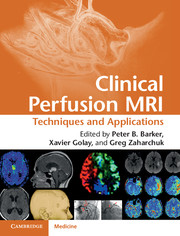Book contents
- Frontmatter
- Contents
- List of Contributors
- Foreword
- Preface
- List of Abbreviations
- Section 1 Techniques
- Section 2 Clinical applications
- 8 MR perfusion imaging in neurovascular disease
- 9 MR perfusion imaging in neurodegenerative disease
- 10 MR perfusion imaging in clinical neuroradiology
- 11 MR perfusion imaging in oncology: neuro applications
- 12 MR perfusion imaging in oncology: applications outside the brain
- 13 MR perfusion imaging in breast cancer
- 14 MR perfusion imaging in the body: kidney, liver, and lung
- 15 MR perfusion imaging in cardiac diseases
- 16 MR perfusion imaging in pediatrics
- Index
- References
16 - MR perfusion imaging in pediatrics
from Section 2 - Clinical applications
Published online by Cambridge University Press: 05 May 2013
- Frontmatter
- Contents
- List of Contributors
- Foreword
- Preface
- List of Abbreviations
- Section 1 Techniques
- Section 2 Clinical applications
- 8 MR perfusion imaging in neurovascular disease
- 9 MR perfusion imaging in neurodegenerative disease
- 10 MR perfusion imaging in clinical neuroradiology
- 11 MR perfusion imaging in oncology: neuro applications
- 12 MR perfusion imaging in oncology: applications outside the brain
- 13 MR perfusion imaging in breast cancer
- 14 MR perfusion imaging in the body: kidney, liver, and lung
- 15 MR perfusion imaging in cardiac diseases
- 16 MR perfusion imaging in pediatrics
- Index
- References
Summary
Introduction
The MR perfusion techniques of dynamic susceptibility contrast (DSC; see Chapter 2) imaging and arterial spin labeling (ASL; see Chapter 3) imaging as applied to children will be discussed. While DSC perfusion is well established in the evaluation of adult neurological conditions, the use of both DSC and ASL perfusion imaging in pediatric neurological conditions remains in its infancy. While acute stroke imaging drove the adoption of DSC approaches in adults, the lack of demonstrated utility in children, the need for intravenous (IV) line placement, and the need for bolus injection has limited its adoption in children. While some groups extrapolate both DSC and ASL approaches and analysis from the adult literature in applying MR perfusion to pediatric disorders, there is still much unknown about pediatric cerebral perfusion and the changes that occur in pediatric diseases. For example, there are normal developmental changes in cerebral vasculature and cerebral perfusion as well as marked changes in body size, heart rate, vascular flow velocities, and capillary development which may impact optimization, quantification, and interpretation of both DSC and ASL. In addition, little is known about how these measures are affected by sedation, anesthesia, and hematocrit changes.
- Type
- Chapter
- Information
- Clinical Perfusion MRITechniques and Applications, pp. 326 - 348Publisher: Cambridge University PressPrint publication year: 2013
References
- 2
- Cited by

